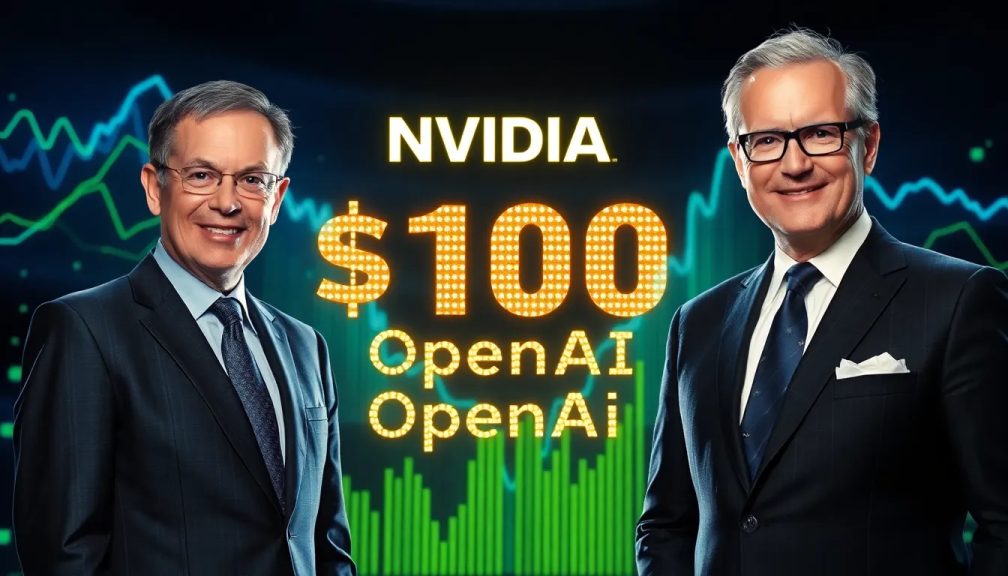NVIDIA and OpenAI sign historic $100 billion AI GPU deal

The landscape of artificial intelligence is rapidly evolving, and the recent partnership between OpenAI and NVIDIA is a testament to this transformation. As generative AI continues to gain traction globally, the demand for advanced hardware to support these technologies is surging. This collaboration is set to redefine the capabilities of AI systems and push the boundaries of innovation in the tech industry.
OpenAI has embarked on a monumental investment journey, committing to a massive $100 billion deal with NVIDIA. This agreement symbolizes not only a financial transaction but also a strategic alliance aimed at enhancing AI infrastructure for the future.
OpenAI's $100 Billion Investment in NVIDIA's AI Technology
As interest in generative AI surged, NVIDIA recognized an incredible opportunity. The company, once primarily focused on gaming graphics cards, has successfully pivoted toward AI technology, significantly boosting its revenue. With the rise of OpenAI and its popular initiatives like ChatGPT, NVIDIA's GPU offerings for AI have outpaced traditional gaming hardware in profitability.
This collaboration comes at a time when NVIDIA has climbed to the top of the market capitalization rankings, surpassing tech giants like Microsoft, Apple, and Google. The company's shift to AI has proven lucrative, showcasing the potential of AI-driven solutions in various sectors.
OpenAI's agreement with NVIDIA entails a groundbreaking investment in "multi-GW projects." Specifically, OpenAI will procure state-of-the-art AI racks from NVIDIA's new Vera Rubin platform, designed to handle substantial workloads with a consumption capacity of 10 gigawatts.
Such a monumental agreement signifies the scale of resources required to foster advanced AI capabilities. As a point of comparison, this consumption level exceeds that of Meta, which previously announced the establishment of new AI-focused data centers consuming over 2 gigawatts.
What OpenAI Will Gain from the Agreement
The agreement ensures that OpenAI will acquire a staggering number of resources. Specifically, the company plans to receive approximately 40,000 racks of NVIDIA's latest GPU technology, a critical step in bolstering its AI infrastructure. These racks will play a pivotal role in the training and inference processes of AI models.
While the official production of these advanced GPUs is scheduled for the second half of 2026, the potential power available to OpenAI upon release is substantial. Here are some key features of the NVIDIA Vera Rubin architecture:
- 128 GB GDDR7 memory capacity
- 30 PetaFLOPS NVFP4 processing power
- Three times the speed compared to previous models, such as the GB300
- 8 ExaFLOPS NVFP4 in high-performance racks
- Possible configurations with up to 150 TB of memory
Anticipating the Future of AI Infrastructure
This collaboration not only emphasizes the immediate benefits of the agreement but also highlights the long-term implications for the AI landscape. As OpenAI gears up to implement this cutting-edge technology, it is positioning itself as a leader in the AI field.
The demand for AI capabilities is expected to grow exponentially. Companies across various sectors are increasingly investing in AI to enhance their operations, improve customer experiences, and drive innovation. OpenAI's proactive approach in securing these advanced GPUs is indicative of its commitment to staying at the forefront of AI development.
The Importance of Advanced GPU Technology
The development and deployment of AI technologies hinge significantly on the underlying hardware that supports them. GPUs, specifically designed for high-performance computing tasks, are essential for processing large datasets required in AI training. With the NVIDIA Vera Rubin architecture, OpenAI is set to leverage several advantages:
- Increased efficiency and speed in AI model training
- Enhanced capacity to handle complex AI tasks
- Scalability to accommodate growing AI workloads
As the demand for AI solutions expands, the capabilities afforded by such advanced hardware will be crucial for organizations aiming to harness AI effectively.
Revolutionizing AI Applications Across Industries
With the impending influx of high-performance computing resources, OpenAI's applications of AI are likely to extend beyond traditional boundaries. Industries such as healthcare, finance, entertainment, and manufacturing could experience transformative changes driven by advanced AI systems powered by NVIDIA's innovative technology.
For instance, in the healthcare sector, AI could dramatically improve diagnostic accuracy, predictive analytics for patient outcomes, and personalized treatment plans. In finance, AI systems could enhance fraud detection, optimize trading strategies, and enable real-time risk assessments. These advancements underscore the critical role of partnerships like the one between OpenAI and NVIDIA in accelerating technological progress.
To further explore the implications of this partnership, you can watch this insightful video that delves into the details of NVIDIA's groundbreaking deal with OpenAI:
In summary, the collaboration between OpenAI and NVIDIA marks a pivotal moment in the evolution of artificial intelligence. With a significant investment in cutting-edge GPU technology, OpenAI is poised to lead the charge into a new era of AI development. As the industry embraces these advancements, the future of AI holds immense potential for innovation and transformation across various sectors.




Leave a Reply